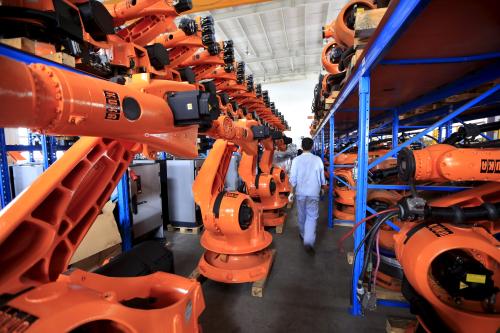A version of this op-ed was originally published in The Hill on September 12, 2019.
September is Workforce Development Month and Congress has until the end of the month to reach an agreement to fund the government, including many workforce and education programs that rely on this investment to help workers prepare for jobs at the backbone of our economy – those that require some postsecondary education but not a four-year degree. These programs have helped prepare millions of nurses, carpenters, computer support specialists and machinists across the country for their careers.
Congressional investment in skills for backbone jobs is overwhelmingly popular. Nearly 80 percent of leaders of small or mid-size companies support new, public investments in skills as do 93 percent of likely 2020 voters. And more than just being popular, voters are 50 percent more likely to vote for candidates who are strong on skills.
But we have done much too little in the U.S. to help workers without BA degrees. Such workers make up two-thirds of all Americans, and their wages have largely stagnated over the past four decades while those with college degrees have made strong advances. Men with high school or less education have been hit particularly hard, as unskilled but well-paid manufacturing and other blue-collar jobs have disappeared. And good-paying in health care, advanced manufacturing, IT and transportation/logistics are out of their reach, since they require education and training that most have not received.
Employers in these sectors also have difficulty finding skilled workers for these jobs, especially in a tight labor market like we now have. More employers could invest in training their workers, but this is a difficult task for small and medium-sized employers who face large startup costs for such training, and who worry that these newly trained workers might not stay with their firms. Such employers can clearly benefit from more training in community colleges, or work-based learning options like apprenticeship in which their participation remain too low.
Making such public investments is growing more critical than ever. In addition to addressing the current needs of workers and employers, our workforce system will soon bear the responsibility of preparing workers for the jobs of the 21st century, responding to changes caused by technology, automation and artificial intelligence (AI). Millions will face possible displacement from their current jobs, and will need to retrain to keep those jobs or find new ones. And the changing demographics of the U.S., as baby boomers age and retire, will require an especially robust effort to prepare those from lower-income or foreign-born families for the new needs of the workplace.
But our public investment in skills hasn’t even come close to meeting workers needs or business demand, let alone achieving parity with the investment of other industrialized countries. According to a recent report from the White House’s Council of Economic Advisers, a report flawed in much of its analysis of workforce academic literature, but accurate in its assessment of U.S. investment, the U.S. would need to invest $80 billion more annually just to reach the average investment other OECD countries. The nearly $19B of federal funding for the U.S. invests in workforce programs constitutes less than one-tenth of one percent of U.S. GDP, a paltry sum in comparison to spending in most European Union countries on “active labor market policy” and for an American economy with 160 million workers.
Instead of recognizing this imperative, Congress has, since 2001, passed spending bills that have cut funding for our public workforce system by 40 percent, for career and technical education by nearly 30 percent and for adult basic education by nearly 15 percent. Even the guidance and other workforce services provided by local One-Stop offices of the Labor Department, which are very clearly cost-effective, have been starved for funds in this era.
Of course, state and federal governments do spend very heavily on subsidizing higher education in public colleges and universities, including community colleges, where certificate and associate degree programs help prepare both youth and adults for the good jobs now available that don’t require BAs. But students in many such shorter-term and non-credit programs are not eligible federal Pell grants and loans, and the colleges themselves are often too strained for cash to expand teaching capacity in these fields or provide guidance and supports (like child care) for students who desperately need them.
The imperative of these investments can be seen by looking at what participation in them can mean for workers and businesses. The best “sector-based” or “career pathway” programs show large and lasting impacts on disadvantaged worker earnings. These mostly local (though now spreading) programs – like Per Scholas, Project QUEST, the Wisconsin Regional Training Partnership, the Jewish Vocational Services-Boston, and Year Up – have generated large and lasting earnings impacts in several rigorous evaluation studies.
Of course, training alone – even robust programing with wrap around supports – isn’t a panacea for economic inequality, the racial wealth gap or business skill needs. But it’s a piece of the puzzle. A sensible policy discussion would focus on how to replicate and scale the best sector-based efforts at community colleges or other training providers with available or new federal and state funding. And Congress can start this conversation now by investing in skills training that works.







Commentary
Op-edFund more investments in non-BA workers
September 26, 2019